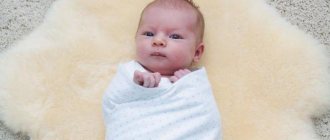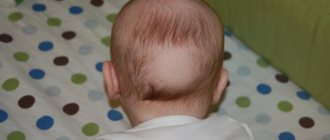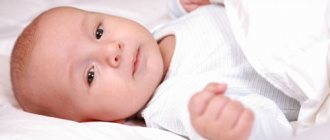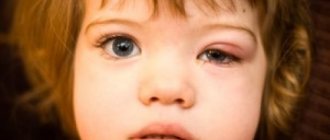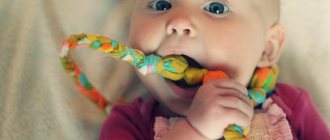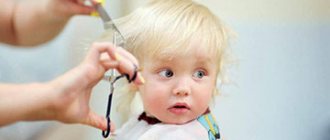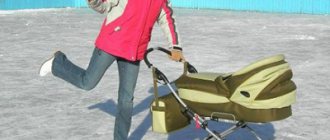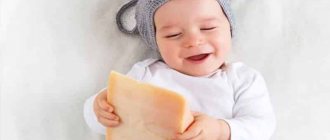Caring for a child is traditionally surrounded by many prejudices and superstitions that we have inherited from earlier times: whether to show the baby to strangers until one month old, whether to “help” walk confidently by cutting the invisible bonds in front of the legs with scissors, etc. With such an abundance of signs, it is not surprising that many mothers are interested in whether it is possible to cut a child’s hair under one year old.
Modern grandmothers (and most often they are the ones who do not advise cutting a child’s hair until he is one year old) are guided by ancient ideas about hair as a kind of source and repository of vitality.
It is worth noting that such beliefs are characteristic of many cultures - from ancient to medieval Japanese. Over time, various prejudices were superimposed on signs and pagan ideas. It is believed, for example, that if parents decide to cut their child’s hair before he is one year old, the color of his hair may change (darken or lighten).
Where did superstition come from?
The sign that you cannot cut your hair until you are a year old is based on an ancient Slavic custom. The fact is that in the old days it was customary to distinguish three stages of human development:
- 1 year – tonsure;
- 3-5 years - Lightning for girls and Mounting on a horse for boys;
- 9-12 years old - Twisting for girls and Girdle for boys.
At these milestones, children experience not only physical but also psychological changes. They begin to perceive the world around them, relationships with other people, and themselves in life differently. Hence the importance of how the next stage of development will be met. It was important to correctly introduce a person into society; depending on his gender, girls and boys had their hair cut differently.
In Ancient Rus', newborn children often died. According to popular belief, up to a year they got used to the family and looked closely. If everything suited them, they stayed with their relatives. If not, they died. That is why parents were forbidden to become attached to children under one year old. When the baby reached the age of 1 year, he had his hair cut, recognizing him as a full member of the family. He ceased to be the “property” of the family and became an individual.
Children were introduced into life in different ways. It was customary for boys to have their hair cut bald. Girls, on the contrary, had their hair cut purely symbolically, with baby fluff lightly trimmed at the four cardinal points. This was explained by the fact that hair is associated with the other world, the sixth sense. Boys, future men, came to this world to build new cities and conquer unknown lands. In other words, they needed to learn to think for themselves. The girls, in turn, needed the help of otherworldly forces, as weaker creatures. They needed to develop their intuition in order to maintain harmony in the family and subtly sense the mood of others.
Important! If the hair still got in the way and got into the eyes, on the new moon at 6 months it was allowed to cut the strands that fell on the child’s face.
First haircut - what should it be?
Many modern parents believe that early haircuts promote healthy and thick hair. However, this statement cannot be called true. After all, these criteria for hair depend on genes and this cannot in any way be associated with early hair removal.
In addition, this process can only irritate the baby. It can also lead to problems with the health of the roots and hair follicles. But for proper hygiene, long strands will interfere, so a slight shortening is still necessary for the child.
If a baby is afraid, it is better not to traumatize his psyche. After all, the main thing is that the baby is comfortable and also that he is healthy.
If parents decide to have a haircut before 1 year of age, this must be done according to all the rules. As a result, the procedure should be as calm as possible. When household members are not sure that they can easily cut a child’s hair without harming him, it is better to give preference to professionals who know a lot about their work.
The most compelling reason why a small child should not be given a haircut is that he may become nervous and restless around strangers and in unfamiliar surroundings. This condition of the child can lead to him being accidentally injured by scissors.
To summarize, it is worth noting that cutting a child under 1 year of age is a voluntary activity for every parent. The main thing is that the baby is comfortable and not afraid, because then it will be problematic to calm the child down.
With the arrival of a baby in the house, various folk beliefs emerge related to caring for the baby, organizing his life in the family, and feeding. You cannot show a child to strangers before baptism, you cannot bathe in the presence of strangers, you cannot look at a sleeping baby, you cannot rock an empty cradle, you cannot cut the hair of a baby under one year old. Almost all mothers adhere to this immutable rule, so you can often find a baby a few months old with hairpins on her head. What is the reason for the ban itself, is it worth adhering to?
Why you can’t cut the hair of children under one year old according to folk wisdom
Violation of an ancient custom is interpreted in different ways. The general negative meaning remains, however, a more precise sign about why you can’t cut a child’s hair up to one year old can be interpreted as follows:
- In Rus', hair was given great importance. They were considered a kind of “channel” that connects a person with the world of higher powers. If this connection is severed before the start of the year, the child’s health can be seriously undermined, since he will be deprived of energy replenishment. The ancestors of the family no longer support him, leaving him alone with illnesses.
- In some regions of Russia, the omen is interpreted in such a way that if you cut a child’s hair before he is one year old, then good luck is cut off along with it. In adult life, he will be unhappy, everything will be difficult for him, and minor troubles will pour in as if from a cornucopia.
- Cutting the hair of small children is a sign of need. In the old days, it was believed that tonsure before a year could bring poverty to a family.
- The pagans had a belief that hair was the center of the human mind. They contained the child’s potential to assimilate folk wisdom. Cutting them before one year means causing learning difficulties for the child. New knowledge will be absorbed much more slowly, the child will not have diligence and patience in learning.
- Also, ancient people associated hair with tongue. According to this interpretation of the custom, it was impossible to cut hair before one year because this would “cut” the baby’s tongue. He might have difficulty communicating in the future. Sometimes children did not start speaking for a long time after getting a haircut at such an early age.
Important! As an exception, it was allowed to cut hair for up to a year at the time of baptism.
Old Church Slavonic version of the ban
The Old Slavic tribes had many beliefs and signs associated specifically with hair. The Slavs called hair “cosms”, thereby indicating the connection between hair and the cosmos at the bioenergetic level. A small child is defenseless and weak in front of the huge world, completely dependent on adults, the hairs on the baby’s head accumulate strength and are a transmission link at the bioenergetic level. If you deprive him of his hair, then there is a possibility that the child will develop a disease or even threaten his life.
Pediatricians' opinion
The vast majority of doctors do not agree that ancient folk customs have any meaning. In the medical community, it is generally accepted that cutting the hair of a child under one year old will not cause him any harm, both physical and spiritual. On the other hand, even they identify a number of reasons that do not in any way connect a haircut with a loss of luck and happiness in the future, but still warn about the dangers of the procedure:
- Babies have very thin and delicate skin on the scalp, which can be easily damaged by sharp objects.
- On the head of babies there are so-called “fontanelles”, free spaces between parts of the skull that close by the age of one year, or even later. If you press on one of the fontanelles, you can inadvertently cause serious injury to it.
- Young children are very active. They are difficult to keep in place, so cutting hair for up to a year can be quite a dangerous task.
- A child under one year old perceives hair in the same way as he sees his arms or legs - as a full-fledged part of his body. Attempts to cut hair for this reason are often met with tears and hysterics. Sometimes the stress is so strong that it negatively affects the future development of the child.
Advice! If your baby's hair grows too quickly, you can still carefully cut it off before the age of one, but not the entire length. It is advisable to cut only the forehead area so that the hair does not get into the child’s eyes. Otherwise, vision problems may occur.
What is the opinion of experts
Most pediatricians believe that hair can be shortened if it bothers the baby. If it is a girl, it needs to be completely cut once or twice to ensure that the hair grows strong and strong. Since they remain fragile until the age of 4, girls should not braid their hair tightly - this will cause thinning of the strands, which will soon resemble fluff in appearance.
Of course, many superstitions and signs do not allow cutting a child’s hair under the age of 1 year. But if he constantly pulls his hair, and at the same time cries and gets angry, it is still better to get a haircut so as not to irritate the child.
How to avoid the consequences predicted in signs
You can mitigate the negative consequences that the sign predicts if you ignore the ancient custom as follows:
- Using the lunar calendar, it is necessary to determine the date of the new moon. On this day, it is necessary to cut the child's hair, and place the first cut strand of hair in a small bag or box. It is removed away from prying eyes - it is advisable that even close people and friends do not know about the hiding place. The child's hidden hair will serve him as a talisman-amulet. He will protect him from failures, damage and the evil eye.
- Trimmed hair can also be stored in a locket. This way they will protect not only the child, but also the mother.
- In order to return to the child the luck and future well-being lost as a result of a broken tradition, it is necessary to “comb” the baby 3, 9 or 13 times not with a comb, but with coins squeezed between the fingers. In the old days, it was believed that such a procedure attracted wealth.
- If the child's hair was cut before a year, but was preserved, you can also put it in a thick book, carefully placing it between the pages. According to popular beliefs, this little trick not only returns to the baby the mental acuity lost due to the parents’ ignorance, but also increases it.
There is also a completely opposite opinion about whether hair cut off for up to a year or on a child’s first birthday should be kept at home. A strand of children's hair can be used by ill-wishers to damage the baby, so they should be burned or buried in the forest.
Advice! To attract good luck and wealth, a strand is buried in an anthill. A crossroads is also considered a place with powerful energy - you can leave your hair there.
Version of the Christian Keepers of Traditions
With the adoption of Christianity in Rus', the tradition of not touching a baby’s hair until he reaches the age of one was preserved, but changed slightly. The baby still could not be cut until he was one year old; on the day the child turned one year old, the midwife who delivered the baby and the godparents had to be invited. The ceremony was called “tonsuring”; the godfather cut off several locks of hair in the shape of a cross from the child. The curls were tied with a red ribbon and tucked behind the main icon in the house, located in the red corner. When the child reached adulthood, the curls were removed from behind the icon. It was believed that such a kind of “amulet” protects the child from the machinations of the evil one.
Parietal crusts
Many babies develop parietal crusts - gneiss - on their heads. This occurs due to increased formation of fat on the scalp. Parents are worried whether the scabs are interfering with hair growth. And if they interfere, then how to deal with them. According to pediatricians, crusts do not in any way affect the growth and condition of hair. By about two years of age, they gradually disappear when fat metabolism returns to normal.
If a mother is worried about her baby's crusts, they can be removed with baby oil. Before bathing, the crusts are greased with oil. After bathing, the hairs are carefully combed with a thick comb with soft teeth, removing loose crusts.
Tools and Techniques
There is no fundamental difference in the use of manual and electric tools, but there is an opinion that the noise of an electric machine can scare the baby or cause some discomfort, after which whims will begin.
Most professional hairdressers specializing in children's haircuts prefer to work with mechanical hand tools, avoiding sharp objects (razors, machines).
There are no guidelines for cutting young children's hair, so each case is individual. The only thing that almost always remains unchanged is the form of play with the maximum interest of the child (watching cartoons or reading fairy tales, poems in the mother’s voice).
Moms' opinion
The opinions of mothers differ radically, because everyone chooses for themselves what seems most reasonable to them. Someone takes a risk and shaves the baby with a machine (allergic reactions can develop under the influence of sunlight or when wearing thick, warm hats).
Another option, when the option that you can’t cut your hair for up to a year wins, mothers try to get out of the situation with grown hair with the help of bobby pins and small “crabs.” And this is also not good, because the scalp does not receive enough oxygen, the sebaceous glands become clogged and there is a high probability of lice.
